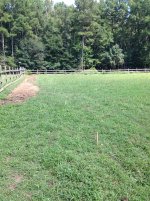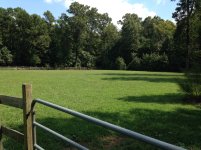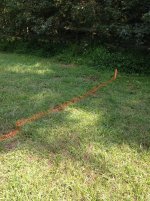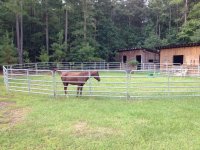Country Geek
Gold Member
I had started and participated in a thread or two here recently about geothermal heat pumps, trying to decide if one is right for me. I've decided to pull the trigger and I'll follow the install on this thread.
Background: I'm replacing a dual-fuel air-source heat pump. The backup furnace is propane. When I built my house propane was $1 a gallon. Now as we all know it's much more, and also much more volatile. Plus, the local market here is quickly evolving into a duopoly as the two big players (Amerigas and Ferrellgas) are systematically buying up all the mom-n-pops. So I just don't think conditions are favorable for propane heating any more. Last January, during the polar vortex, one month of propane cost me $850. And that's at a significant discount because I had signed a contract in the fall and was getting a commercial rate, plus I own my tank so was also getting a favorable rate for that.
My system is also aging and in need of replacement. The refrigerant it uses is being phased out, and the system is in bad shape because it's located in a crawlspace and 15 years of humidity under there plus critters messing with the ducts has taken its toll. To protect against the latter I'm also having my crawlspace encapsulated, which I'll discuss in another post.
I spent some time deciding on a system type. I first got a quote for a solar-assisted air-source heat pump. This is a regular heat pump system plus solar panels through which refrigerant circulates, making the heat pump more efficient. The research I did made me think this was more a gimmick to make a regular heat pump eligible for energy efficiency credits, than a real efficient system. I settled on geothermal because it's by far the most efficient plus I have the land to do a trench system, reducing cost vs wells.
Cost was a factor and here tax credits are a big help. There is a 30% federal tax credit on a geothermal installation. Plus the state of North Carolina has a 35% credit so in the end that works out to over a 50% discount on the system. I say 50% discount, not the 65% discount that would seem apparent because:
I did a lot of doodling around in this spreadsheet: http://www.eia.gov/tools/faqs/heatcalc.xls. Putting in local values and playing around, plus the fact that I have the land to do it, a geothermal system looked like a no-brainer.
I'll be putting in a 5 ton ClimateMaster Tranquility with gas backup. It may sound funny to say I'm getting the gas backup after what I said above, but all research I've done shows that geothermal systems around here almost never need backup heat. The gas backup is just for peace of mind because I can run it off my 5500W generator in the event of an extended power outage (which ice storms out here can cause), or if a problem develops with the geothermal system. The gas backup will be manually controlled, not on a thermostat, so I can turn it on and off as I want. I expect to run it very seldom, but who knows, if the price of propane crashes, I could run it more. I will have 7 trenches, 150 feet each.
The trenches will be in my pasture. While the trenches are being installed and the grass regrown, the horse will be living in the training round pen and her stall. It's an inconvenience but she's old and doesn't need a lot of running room any more so she'll be fine.
Once this project starts my pasture will be completely torn up. So I've attached a picture of what it looks like now, because it won't look this good again for a long time! The pasture also has a french drain through it that will need to be avoided by the trenches, it's marked with the orange spray paint. Finally, the horse in her temporary lodging.




Background: I'm replacing a dual-fuel air-source heat pump. The backup furnace is propane. When I built my house propane was $1 a gallon. Now as we all know it's much more, and also much more volatile. Plus, the local market here is quickly evolving into a duopoly as the two big players (Amerigas and Ferrellgas) are systematically buying up all the mom-n-pops. So I just don't think conditions are favorable for propane heating any more. Last January, during the polar vortex, one month of propane cost me $850. And that's at a significant discount because I had signed a contract in the fall and was getting a commercial rate, plus I own my tank so was also getting a favorable rate for that.
My system is also aging and in need of replacement. The refrigerant it uses is being phased out, and the system is in bad shape because it's located in a crawlspace and 15 years of humidity under there plus critters messing with the ducts has taken its toll. To protect against the latter I'm also having my crawlspace encapsulated, which I'll discuss in another post.
I spent some time deciding on a system type. I first got a quote for a solar-assisted air-source heat pump. This is a regular heat pump system plus solar panels through which refrigerant circulates, making the heat pump more efficient. The research I did made me think this was more a gimmick to make a regular heat pump eligible for energy efficiency credits, than a real efficient system. I settled on geothermal because it's by far the most efficient plus I have the land to do a trench system, reducing cost vs wells.
Cost was a factor and here tax credits are a big help. There is a 30% federal tax credit on a geothermal installation. Plus the state of North Carolina has a 35% credit so in the end that works out to over a 50% discount on the system. I say 50% discount, not the 65% discount that would seem apparent because:
- The state tax reduction also reduces your state income tax deduction on your federal taxes, so for all practical purposes you pay federal income tax on the state tax credit
- The NC credit is capped at $10,500
I did a lot of doodling around in this spreadsheet: http://www.eia.gov/tools/faqs/heatcalc.xls. Putting in local values and playing around, plus the fact that I have the land to do it, a geothermal system looked like a no-brainer.
I'll be putting in a 5 ton ClimateMaster Tranquility with gas backup. It may sound funny to say I'm getting the gas backup after what I said above, but all research I've done shows that geothermal systems around here almost never need backup heat. The gas backup is just for peace of mind because I can run it off my 5500W generator in the event of an extended power outage (which ice storms out here can cause), or if a problem develops with the geothermal system. The gas backup will be manually controlled, not on a thermostat, so I can turn it on and off as I want. I expect to run it very seldom, but who knows, if the price of propane crashes, I could run it more. I will have 7 trenches, 150 feet each.
The trenches will be in my pasture. While the trenches are being installed and the grass regrown, the horse will be living in the training round pen and her stall. It's an inconvenience but she's old and doesn't need a lot of running room any more so she'll be fine.
Once this project starts my pasture will be completely torn up. So I've attached a picture of what it looks like now, because it won't look this good again for a long time! The pasture also has a french drain through it that will need to be avoided by the trenches, it's marked with the orange spray paint. Finally, the horse in her temporary lodging.




